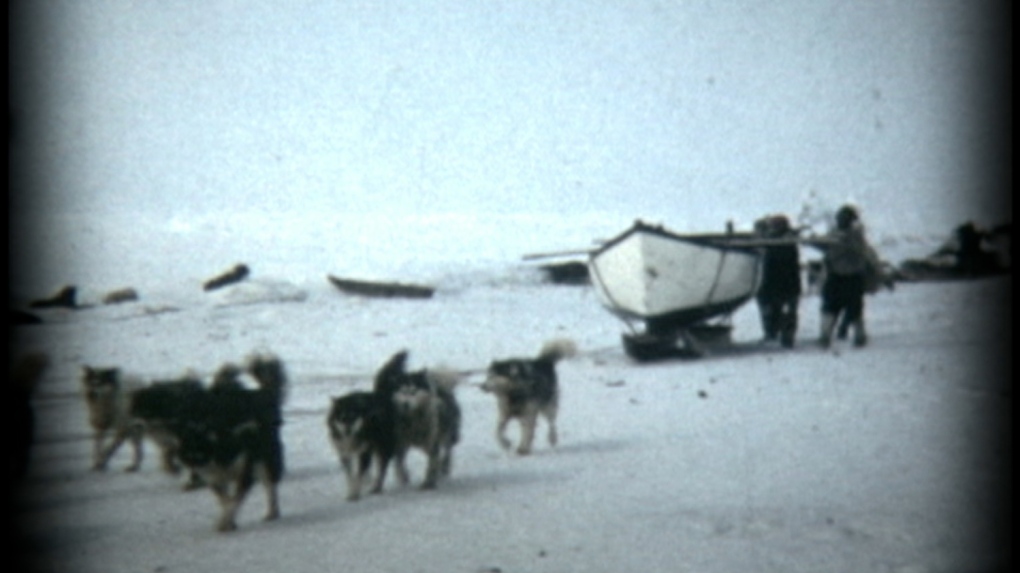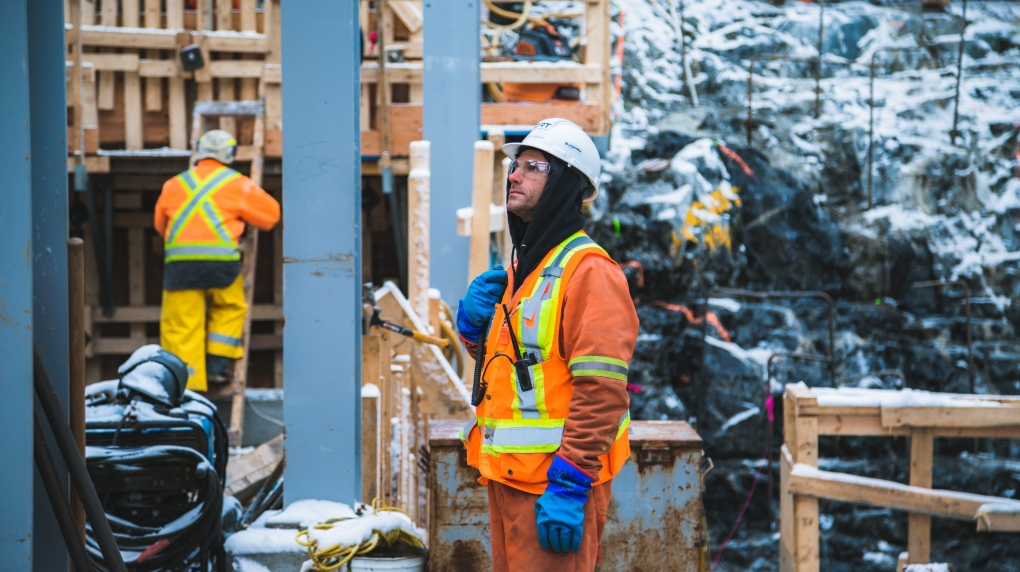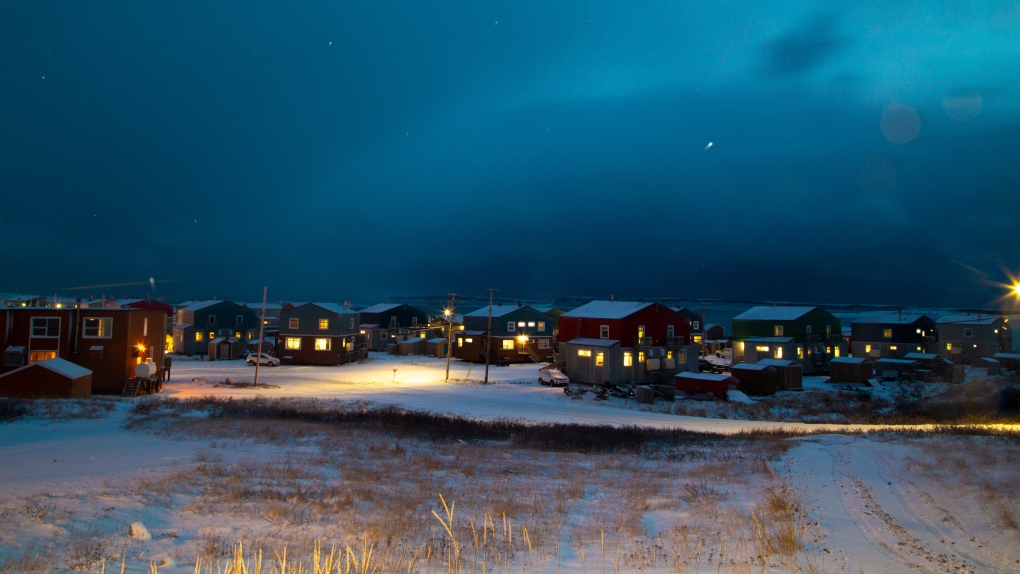Inuit community leads Arctic shift to clean energy: hydroelectric project to replace diesel
NOTE -- This article is part of a collaborative news interactive on energy leadership in Nunavik. To be directed to the home page, click here
Razor-sharp winds whip across an arctic landscape as Eric Atagotaaluk carefully makes his way down to the shore of the Inukjuak river, in Arctic Quebec. On this day, freezing temperatures make handling the water testing equipment difficult, but Atagotaaluk persists. Every morning and every night he is here, testing and re-testing. It is a promise he made to the people of Inukjuak long before construction even started.
"It was a concern," said Atagotaaluk, the director of the Pituvik Landholding Corporation. "The community wanted to make sure the quality of the water wouldn't be impacted."
Atagotaaluk is standing only a few metres away from the construction site of Innavik, a hydro-grid that will allow the community of Inukjuak, Que., to stop using dirty diesel energy and heating oil, and move towards sustainable alternatives instead.
"Very normal," he said of the test results, with a smile on his face. "It’s a good sign."
A first-ever partnership between Pituvik Landholding Corporation — which is responsible for land and development — Hydro-Québec, and Montreal-based renewable energy company Innergex is set to provide clean energy to households in Inukjuak, an Inuit community on the shoreline of the Hudson Bay.
 In this image collage, Eric Atagotaaluk is seen doing his daily water test at the Innuksuak River. Upstream, construction is underway on a massive hydro electric project which will eventually get the community off diesel. These daily water tests were part of a community promise to ensure that the construction doesn't affect the quality of the river, which also supplies the community with drinking water. (Kaaria Quash)
In this image collage, Eric Atagotaaluk is seen doing his daily water test at the Innuksuak River. Upstream, construction is underway on a massive hydro electric project which will eventually get the community off diesel. These daily water tests were part of a community promise to ensure that the construction doesn't affect the quality of the river, which also supplies the community with drinking water. (Kaaria Quash)
The Innavik Project was initiated in 2008 to lower local greenhouse gas emissions, and, once completed, will reduce carbon emissions by close to 80 per cent.
"Climate change is very apparent here," Atagotaaluk said, reflecting on the impact of living with diesel.
"Our fall and spring seasons are starting earlier or later, and you kind of feel trapped, and you want to do something for the climate. Although we are not big contributors to greenhouse gas emissions, we still do use a lot of diesel."
About 1,800 people live in Inukjuak, one of 14 Inuit communities in the Nunavik region of Quebec. The town is located 1,500 kilometres north of Montreal and is accessible only by air.
Inukjuak is built on rock and permafrost, surrounded by ribbons of untamed rivers and stretches of wild tundra north of the treeline — the point after which trees are incapable of growing.
For decades, every single building, car and house has been reliant on diesel for power, fuel and heat, even though diesel is an energy source known to be harmful to the environment.
The diesel tanks are everywhere, whether they line the side of schools, grocery stores, or one of the community’s 500 homes.
For community member Tommy Palliser, living off diesel for most of his life has meant facing a constant risk of pollution — and energy shortage.
"The fuel truck comes once a month, and sometimes we run out of it," said Palliser, who is also the executive director of the Nunavik Marine Region Wildlife Board.
"We don't have any heat for a day or two. Sometimes you can smell the diesel even if it’s a small spill; you can smell it in the whole house. And it’s pretty hard to get rid of."
 Nunavik Marine Region Wildlife Board Executive Director Tommy Palliser gestures towards the diesel tank attached to the side of his home. He says its common for these tanks to rust and leak, wasting fuel, and sending fumes inside the house. (Kaaria Quash)
Nunavik Marine Region Wildlife Board Executive Director Tommy Palliser gestures towards the diesel tank attached to the side of his home. He says its common for these tanks to rust and leak, wasting fuel, and sending fumes inside the house. (Kaaria Quash)
In 2015, more than 13,000 litres of diesel spilled in the community as fuel was being transferred from one tank to another. Diesel ended up soaking and contaminating the surrounding soil, prompting a costly and time-consuming cleanup.
The disaster came only a month after about 14,000 litres of diesel spilled in Ivujivik, north of Inukjuak. That same year, an additional 3,000 litres of diesel spilled in Salluit, another community in Nunavik.
Palliser, who is also the Executive Director of the Nunavik Marine Region Wildlife Board, said the hydro project will not only provide a safer environment along with clean and sustainable energy, but its revenue will bring the community a step closer to self-determination.
"It's not easy, for us as Inuit communities, to get the quality services we certainly deserve," Palliser said.
"There's a lot of issues that affected our community, relocation, dog slaughter … That's what I've been trying to talk about, this project is to try and roll up our sleeves and become independent … That’s how we resolve our issues."
MOVING AWAY FROM THE PAST
Community elder Abraham Kasudluak remembers a time when everything was different.
"A lot has changed," Abraham said.
"There used to be only three houses around the community. The only white people that lived here were from the Hudson Bay company, the church, RCMP and from the department of transportation."
Abraham, 84, recalled how life started to change in the 1950's. Two major events, he said, that shifted Inukjuak’s entire history was the relocation of families and the slaughtering of dogs.
 Community elder Abraham Kasudluak tells stories in his Inukjuak home in the fall of 2021. (Kaaria Quash)
Community elder Abraham Kasudluak tells stories in his Inukjuak home in the fall of 2021. (Kaaria Quash)
Between 1953 and 1955, nearly two dozen families were relocated by the federal government from Inukjuak to Grise Fiord and Resolute, in the High Arctic. Ottawa argued at the time the relocations were meant to affirm Canadian sovereignty in these areas, and promised the families they would be allowed to return home after a few years.
The families, however, were separated and not given the proper tools — such as hunting and camping gear — to survive. Most of them never made it back to Inukjuak.
"I knew all of them," Abraham said. "We were lied to … We were told that they were there only for two years, but it took too many years to return."
In 2010, Ottawa apologized for the High Arctic Relocation and recognized that it resulted in “extreme hardship and suffering” for Inuit families.
Former Mayor of Inukjuak Simeonie Nalukturuk said the impact of forced relocation has resulted in intergenerational trauma.
"A third of the people for the territory here was taken away by the government," Nalukturuk said. "They promised a whole bunch of good things … everybody knows these promises were not kept."
The community’s sufferings were all the more aggravated by the so-called "dog slaughter," Nalukturuk continued.
He explained that qimmit, known in English as Inuit sled dogs, were nearly all wiped out by the RCMP and Quebec provincial police. Between the '50s and the '70s, thousands of sled dogs across Nunavik, including in Inukjuak, were killed by the police, who reportedly said at the time the cull was carried out for health and safety reasons.
"The killings of dogs, I see it now as a tool to further assimilate the Inuit into a mainstream Canadian way of life, to weaken them from their lands," Nalukturuk said, adding that dogs were an integral part of the Inuit’s nomadic life and hunting culture. "Our way of life was altered. Our men, when they lost their dogs, they lost the ability to hunt for their families."
While Quebec has acknowledged the negative effects the mass slaughter of sled dogs had on the Inuit 10 years ago, a 2006 RCMP investigation cleared the federal government of any wrongdoing.
The report stated the RCMP review committee "didn't uncover any evidence to support the allegations … of an organized mass slaughter of Inuit sled dogs by RCMP members in Nunavik and Nunavut between 1950 and 1970."
"The destruction of Inuit sled dogs, and other dogs, was undertaken by RCMP members for public health and safety reasons, in accordance with the law, to contain canine epidemics, and at times, at the request of the dogs' owners," the report said.
 Arctic sled dogs are seen in this image taken from National Film Board of Canada's "Qimmit: A Clash of Two Truths" which follows the history Canadian dog slaughter in the Arctic. Sled dogs were, and remain, a regular mode of transportation for Inuit living in the north. (Photo courtesy of the NFB)
Arctic sled dogs are seen in this image taken from National Film Board of Canada's "Qimmit: A Clash of Two Truths" which follows the history Canadian dog slaughter in the Arctic. Sled dogs were, and remain, a regular mode of transportation for Inuit living in the north. (Photo courtesy of the NFB)
The lack of recognition from Ottawa left unhealed wounds on the community, but Nalukturuk said he now hopes economic benefits from the hydro-grid will empower younger generations.
- An extended interview with the late Simeonie Nalukturuk is available here. It contains details some may find distressing.
Palliser and Nalukturuk’s common desire to see Inukjuak emerge and benefit from the hydro-grid project echoes Pituvik’s ambition.
"We need to heal first of all," Sarah Lisa Kasudluak, president of Pituvik Landholding Corporation, said. "And I think that’s really going to help, with this project, we can get resources."
"I had to really think ahead on what kind of future I want for my people. I really want my people to be able to stand on their own feet and to be able to do stuff on their own."
The latest Census data from 2016 showed Inukjuak had one of the highest unemployment rates in Canada, at 23 per cent compared to a national average of seven per cent.
Kasudluak said she wants to target education and unemployment with the revenue from the hydro plant.
"This is something that is very futuristic, that will make our people stand on their own," Kasudluak said. "It's a modern way to produce energy and use our resources."
OWNERS OF INNOVATION
Construction began in 2020 after being delayed due to the pandemic, following decades of collaborative work between Pituvik, Hydro-Québec and Innergex. The overall estimated cost is $125 million dollars, and is being financed through a series of partnerships, loans and grants.
Innergex, a renewable energy leader based in Quebec, is overseeing the construction and operation with the Pituvik Landholding Corporation under a 50-50 partnership. The 7.5-megawatt hydro plant is scheduled for commercial operation in early 2023.
The project is a run-of-river power plant, which uses the steady flow of water to spin energy turbines. Water is then returned to the river, with little to no storage, unlike traditional hydro electric dams. For the time being, diesel generators will stay in place as a backup source of electricity.
Pituvik and Innergex will split the revenue equally. Both signed a 40-year power purchase agreement with Hydro-Québec. Over that term, the partners are expected to generate tens of millions of dollars in net profit.
The partnership is not only a milestone in Quebec, it is also the first of its kind in all of the North American Arctic region.
"It's a challenge of a lifetime … to be the first one to build a structure like that in the north," CRT construction project director Alain Labonté said.
Labonté said many consultations on the project, which is located 10 kilometres from town, were made with the community beforehand.
"The river here is the source of water they are drinking every day, and we are building an infrastructure upstream of the intake, that’s the challenge, to make sure the water stays in the same condition that it was before," Labonté said, adding that there had been concerns over flooding and contaminated water in the community.
 A worker stands in the construction site for Inukjuak's hydroelectric project which, once completed, will provide a surplus of energy to the community, which presently relies on diesel. The construction season is restricted to warmer months, and materials can only be flown to the site, or brought in by boat. (Kaaria Quash)
A worker stands in the construction site for Inukjuak's hydroelectric project which, once completed, will provide a surplus of energy to the community, which presently relies on diesel. The construction season is restricted to warmer months, and materials can only be flown to the site, or brought in by boat. (Kaaria Quash)
Inukjuak's community members voted in favour of the project by close to 80 per cent in 2010. Some members, however, have raised concerns over the impact it would have on the water quality and environment.
Davidee Inukpuk is among the members who fear the project will have negative consequences, particularly when it comes to diverting the river to build the dam.
"We drink that water, we hunt on it, our animals depend on it," he said.
The project has been subject to environmental and social impact assessments for the past 10 years to monitor and mitigate impacts, and to put compensation measures in place. Labonté also said because the hydro plant will not store water in excess of the high-water mark, the possibility of flooding is eliminated.
Atagotaaluk, who monitors the water days and nights, said the community’s concerns are the very reason it is crucial for him to do things right.
"We are going to continue testing the water as long as the construction activity is going on," he said.
"Before the river freezes off."
For Sarah Lisa Kasudluak, the timing of the project couldn’t be better.
"Fifteen years ago, nobody was ready for it," she said.
"I think our timing is kind of perfect for the world to follow our change … I see my people standing on their own feet, working on their identity, culture and themselves."
 The Inukjuak, Que. skyline is seen in fall, 2021. The lights illuminating these houses are powered by diesel, which is the principal source of energy in the community of about 1,800. (Kaaria Quash)
The Inukjuak, Que. skyline is seen in fall, 2021. The lights illuminating these houses are powered by diesel, which is the principal source of energy in the community of about 1,800. (Kaaria Quash)
CTVNews.ca Top Stories

Hong Kong police issue arrest warrants and bounties for six activists including two Canadians
Hong Kong police on Tuesday announced a fresh round of arrest warrants for six activists based overseas, with bounties set at $1 million Hong Kong dollars for information leading to their arrests.
U.S. president-elect's son shares post on X of Donald Trump buying Canada on Amazon
U.S. president-elect Donald Trump and those in his corner continue to send out strong messages about Canada.
What is flagpoling? A new ban on the practice is starting to take effect
Immigration measures announced as part of Canada's border response to president-elect Donald Trump's 25 per cent tariff threat are starting to be implemented, beginning with a ban on what's known as 'flagpoling.'
Trudeau sends Christmas greetings. Read his full message
Prime Minister Justin Trudeau issued his Christmas message on Tuesday. Here is his message in full.
Heavy travel day off to a rough start after American Airlines briefly grounds all flights
American Airlines briefly grounded flights nationwide Tuesday due to a technical problem just as the Christmas travel season kicked into overdrive and winter weather threatened more potential problems for those planning to fly or drive.
Economists say more room to fall as Canadian dollar continues downward trend
Experts say the next few months are going to be rough for the Canadian dollar as it appears set to continue its downward trend.
How much is too much alcohol over the holidays? A doctor explains
The holidays are here, as are the parties, happy hours and other get-togethers that often offer abundant mixed drinks, beer and wine.
Storms to continue rolling through B.C.'s South Coast over Christmas Day
The tempestuous weather that descended on southern B.C. Monday afternoon will linger for the next few days, with a storm forecast for Christmas Day.
The Santa Awards: Ranking the best (and most ridiculous) Father Christmases ever to grace our screens
Behold, for your festive perusal, some of the most beloved, cherished and out-there onscreen renditions of dear old Saint Nick.

































